Anyone who has visited Chiang Mai, Thailand, has heard about the 36 temples (wats) within the Old City walls. Similarly, most visitors visit the spectacularly gilded Doi Suthep temple, an important wat that offers stunning views over Chiang Mai from its hillside perch atop Doi Suthep Mountain. Yet the site that may hold the most significance for this ancient Lanna capital is virtually unknown. The ruins of the city of Wiang Kum Kam, largely ignored and unknown, should rank high on any list of places to visit in northern Thailand.
Built by King Meng Rai in the latter part of the 13th century, the city of Wiang Kum Kam was intended to serve as the the municipal center of the kingdom he had stitched together from Burmese, Lao, and ancient Tai cultures. He located the city on the eastern shore of the Ping River, about five miles south of present day Chiang Mai. Unfortunately, the site flooded severely and just a few short years later, a major flood buried all but a couple of temples beneath nearly 10 feet of mud and sludge. Mengrai abandoned Wiang Kum Kam and moved his capital up the river to the present day site of Chiang Mai.
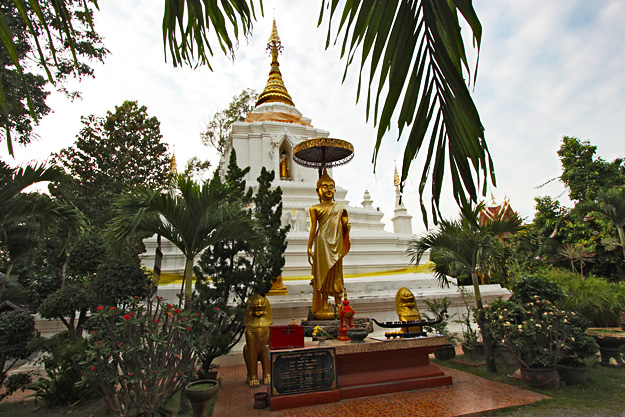
As if following Mengrai’s lead, the Ping River shifted course away from Wiang Kum Kam and over the next few hundred years the memory of the city faded away until the ancient “underground city” was thought to be mythical. Events took a major turn in 1984 when a restoration was begun on Khan Tom Chedi at Wat Chang Kam, one of the few structures in the ancient city that had escaped the floods. During the work, villagers came across dozens of votive tablets, small portable Buddhist images that were often carried home from sacred sites by pilgrims. Based on this find, archeologists from the Fine Art Department began excavations in the area and soon discovered that the myth was rooted in reality.
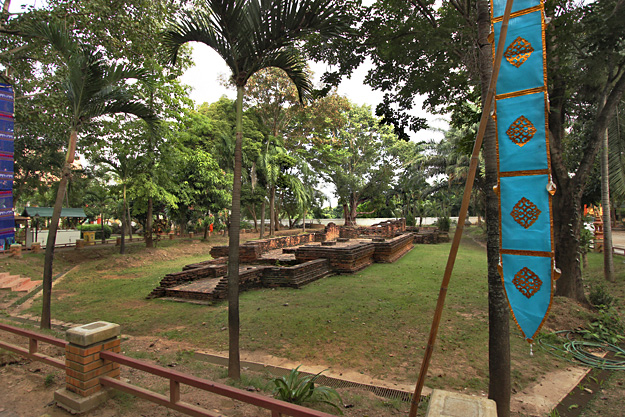
To date, 42 sites have been unearthed and archeologists continue to look for more, including the original royal palace. Progress is slow, as digging must be done around the teak cottages that have sprung up in what is today a suburb of Chiang Mai. The most significant of the ruins, Wat E-Khang, Wat Nanchang, Wat Pu Pia, Wat That Khao and Wat Ku Par Dom, can be seen on tours conducted by villagers, who transport visitors in open-air motorized trams that hold large groups or horse-drawn carriages for 2-4 passengers.
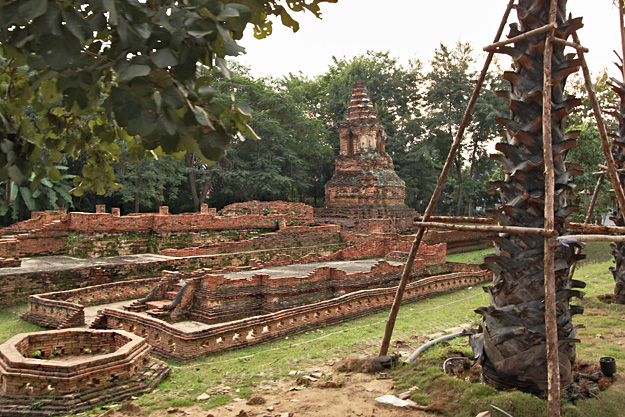
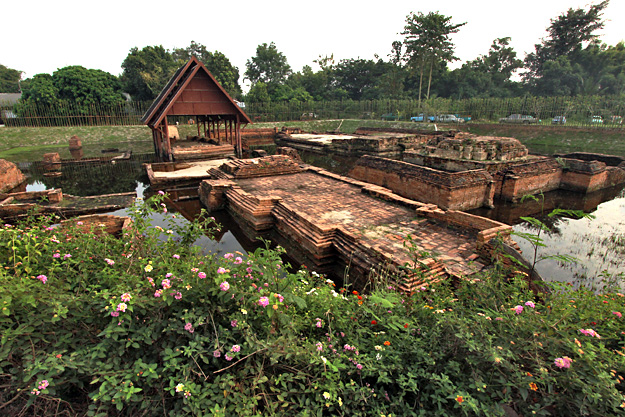
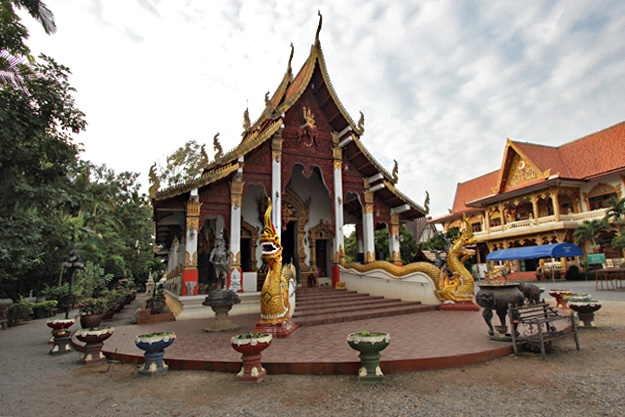
Trams and wagons depart from Chedi Liem, another structure that was not affected by the floods that buried the remainder of the city. This ornate five-tiered stupa, unquestionably the jewel of the ancient Lanna capital, was restored in 1908 by a Burmese merchant, who added touches including Buddhas statues draped in yellow Burmese colors. Adjacent to the Chedi is the glittering prayer hall (Viharn), which has also been restored and is worth a visit.
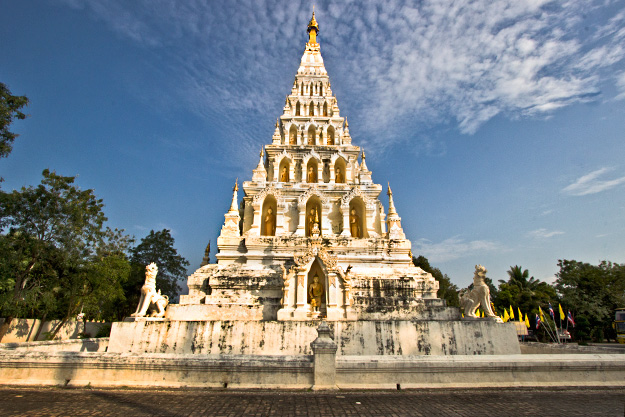
The Underground City of Wiang Kum Kam is not covered in gold leaf like the stupa at Doi Suthep, nor is it impressively ornate like so many of the temples within the old walled portion of Chiang Mai, but it does offer an authentic glimpse into the original Lanna culture from which Chiang Mai evolved. It is remarkable to stand at the edge of excavation pits and look across to the new homes that surround them. Given that Thais are exceptionally superstitious, especially with respect to ancestors and ghosts, I couldn’t help but wonder how they feel about living in houses built upon an ancient city buried ten feet beneath their feet.
How to Visit Wiang Kum Kam:
Any taxi driver in Chiang Mai will be able to take you to the site, but be sure to negotiate for the driver to wait while you tour the site and pay after you have returned to Chiang Mai. Once there, trams and carriages cost between 150-200 Baht per person ($5-6.50 USD). Tours are available in English, though it is better to call in advance to arrange for an English-speaking driver/guide. For more information or to reserve a tour call +66 (0) 5327 7322.
Though the tours allow passengers to disembark and take photos at each ruin site, the stops were considerably too short for me. Next time I will walk between the ruins, which will also allow me to visit the Wiang Kum Kam Information Centre, where exhibitions and a multimedia program explain the geography, politics, and architecture of the Lanna culture.

Hi,
This was a great post!
It was very interesting and I really enjoyed reading it
Well done! Thanks for sharing.
hanks so much Raymond
It is very nice blog about Thailand. This blog showing there culture. I am impressed with this blog. Photos are really awesome and unique.
Hi, where did you stay in Chiang Mai – did you try out the Le Meridien?
Hi Mighty Travels. I stayed at Smith Residence, just south of Chiang Mai Gate. Have not tried Le Meridien.
Aaahhh, I missed this place when I was in Chiang Mai. Great story of the history behind this place.
Thanks Mark – it was definitely a find!
Thanks for sharing, I had never heard of this before. Sounds like a great excuse for me to head back to Chiang Mai! 🙂 Love your photos
Awesome photos, absolutely lovely place. I wish it was not that expensive to fly there from Europe. Thanks for sharing, great post.
Hi Cestovanie: Yes, flights are really the most expensive part of my travels, but if you think it’s expensive form Europe, you’d be shocked at what it costs from the U.S. You might check into Air Berlin or Turkish Airlines, as they both fly to Bangkok and have better prices.
Indeed a wonderful and mysterious place! We went there in January and a few friends by a song thaew from Thapae Gate (400 THB in total for one way drive). Is really a big difference when you walk by yourself. The complex is huge and we enjoyed a lot when walking almost alone there under the hot sun 🙂
Thanks for your comment Ivana. You’ve confirmed my idea that walking next time would be even better.
Whoa nice post !!! …i have heard lot about this place. Looking forward to visit this summer.
Hi Mary – glad my story was a help. I’m sure you’ll love it.
I’m not much of a culture person, but this is enthralling … when I am in Chiang Mai next, I’ll definitely pop by!
Glad you found it interesting Caroline.
Wow Barbara, I’ve been there once and took a few photos with a friend, but I had not idea what was the story behind it or even that there was an ancient underground city … I’m amazed!
If you go back, you’ll see it with different eyes, Yara 🙂
Wow, I’ve been to Chiang Mai twice and never heard or seen this place. What a magic abandoned city with all those superb temple remains. Enchanting story.
I KNOW Mark! I’ve been to Chiang Mai at least three times over the years and had never heard of it before. It makes a difference, as you well know, when you stay long term, and this time I stayed two months, which let me discover some lesser-known spots.
Your tips on how to visit Wiang Kum Kam is very helpful to traveler like me. I remember when i first travel to Kiama. It was indeed challenging.,. Thanks for your posts it is really helpful.